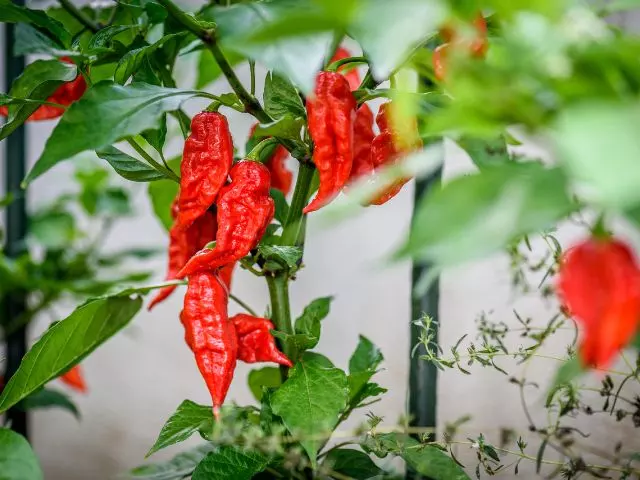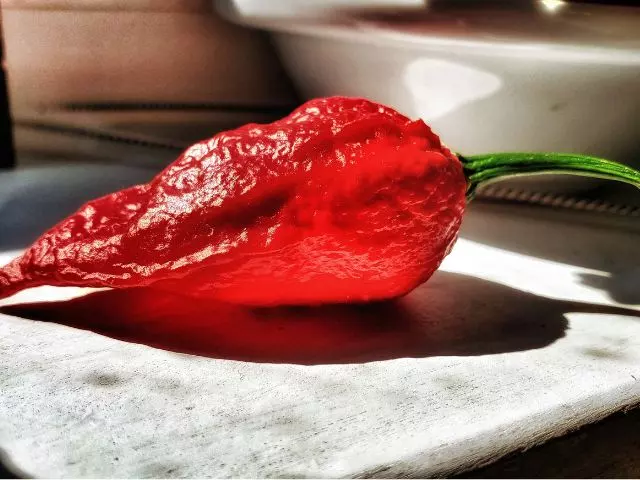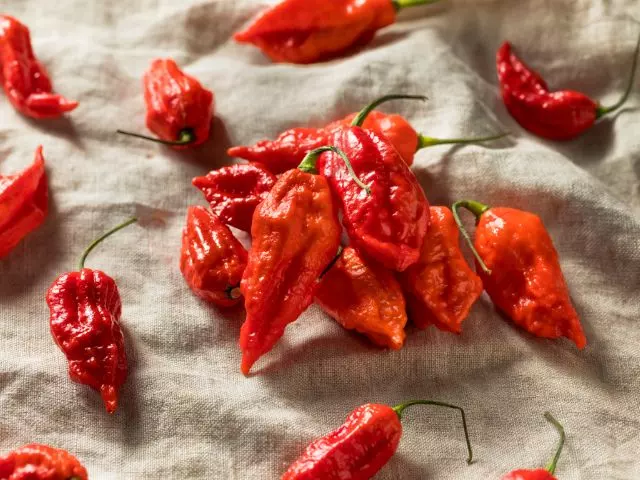Ghost peppers are the hottest peppers in the world. Ghost peppers are twice as hot as the previous “champion”, the Red Savina peppers. This variant reaches Scoville Heat Units of 800,000 to 1001300. One drop of this pepper extract needs a million drops of water, so the spiciness does not go unnoticed. Continue reading to find out when to pick ghost peppers correctly.
Compared to a jalapeno, Ghost peppers are 125 times hotter. The peppers come from northeast India, mainly from Assam, Nagaland, and Manipur. The plants are 18″ to 48″ (45 to 120 cm) tall, and the ghost peppers are 2″ to 3″ (5 to 8.5 cm) long and have a diameter of 1″ to 1.2″ (2.5 to 3 cm).
Ghost pepper plants have a long growing season. Some plant flowers may fall off in this species. Please be careful when planting; you should handle the peppers and their seeds with plastic gloves.
Table of Contents
Types of Ghost Pepper Plants
There are a few different types of ghost pepper plants, which can vary in appearance and heat level. Here are some popular varieties of ghost peppers:
Bhut Jolokia: This is the original ghost pepper variety with a heat rating of over 1 million Scoville Heat Units (SHU). The pods are usually wrinkled and elongated, with a red or orange color when fully ripe.
Red Ghost: The Red Ghost pepper is a slightly milder variant of the Bhut Jolokia but still packs a lot of heat. The peppers are similar in appearance to the original variety, with a red color when fully mature.
Chocolate Bhut Jolokia: As the name suggests, this ghost pepper variety is chocolate brown when ripe. It has a similar heat level to the Bhut Jolokia and is favored by some for its unique flavor.
Yellow Bhut Jolokia: This ghost pepper variety produces yellow pods instead of the usual red or orange color. It has a similar heat level to the Bhut Jolokia. Still, some people find it to have a slightly different flavor profile.
Peach Bhut Jolokia: The Peach Bhut Jolokia is a relatively new variant of the ghost pepper. It has a peachy color when fully ripe and is known for its fruity flavor and intense heat.
These are just a few examples of the different types of ghost pepper plants available. Each variety may vary slightly in heat level, flavor, and appearance. Still, they all share the characteristic high spiciness that makes ghost peppers famous.
When to Pick Ghost Peppers
Ghost peppers typically take around 120 to 130 days to reach maturity from the time of transplanting. However, the exact timing can vary depending on growing conditions, climate, and the specific variety of ghost pepper you are cultivating.
For example, if you plant your ghost peppers in April, you should be picking your ghost peppers between August and September. Of course, these dates are estimates and may vary depending on weather conditions and other factors such as seed quality.
If you pick a ghost pepper when still green, you will see the taste is milder, not that spice. So picking green ghost peppers is a good choice if you prefer a milder spicy flavor.
If you want super-hot ghost peppers, wait until they are fully ripe to pick them out of the plant. As soon as you notice that the ghost peppers are bright red and firm to the touch, that is the right time to pick the ghost peppers. Yellow, peach, and chocolate types of ghost peppers will reach their respective colors as they mature.
It’s worth noting that some gardeners prefer to leave some peppers on the plant to continue ripening, as they can develop an even hotter flavor. However, balancing this with the risk of overripening is essential, where the peppers may become soft or begin to spoil.

How to Pick Ghost Peppers
To pick ghost peppers, I recommend using scissors. This way, you will not damage the plant by pulling the peppers, and the plant will continue to produce. Ghost bell pepper plants are perennial and will continue to produce for a long time.
Use sharp, disinfected scissors to pick the ghost peppers. I recommend wearing nitrile gloves and goggles to avoid skin and eye irritation. Avoid touching your eyes after picking ghost peppers if you do not wear gloves.
Place the harvested ghost peppers in a paper bag or a ventilated container to allow air circulation. Avoid using plastic bags, as they can trap moisture and cause the peppers to spoil quickly. Store them in a cool, dry place or refrigerate them for longer shelf life. Do not wash ghost peppers until consumed.

How Many Ghost Peppers Does a Plant Produce
The number of ghost peppers produced by a single plant can vary based on various factors such as growing conditions, plant health, care, and the specific variety of ghost pepper. On average, a healthy and well-cared-for ghost pepper plant can yield anywhere from 50 to 200 peppers or even more throughout its growing season.
Last year we grew ghost peppers at our house, and a single plant gave us about 150 ghost peppers. The seeds I used were quality, and the plant always received all the care needed to produce an abundance of ghost peppers.

Final Conclusions
In conclusion, knowing the right time to pick your ghost peppers is crucial to enjoying their fiery flavor and intense heat. If you wish to consume ghost peppers that are not so hot, you can harvest them when they are green. If you are passionate about peppers, I recommend you read our article about when to harvest Anaheim peppers.

